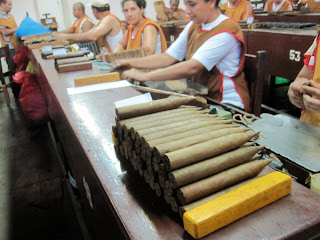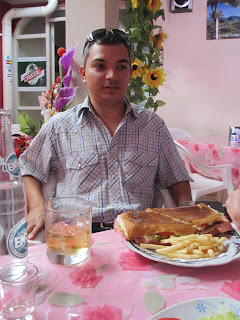 My Father's Cigar - like cigar mecca.
My Father's Cigar - like cigar mecca.
My first exposure to a Tatuaje cigar was back in 2004 during a trip to Hawaii and staying at The Porn King's house overlooking Honolulu. The Porn King was excited about a new cigar called the Rare Cojonu 2003. A stellar cigar, packed with flavor, spice and a nice punch. A breakthrough cigar made by relative unknown Pepin Garcia for Pete Johnson's six accounts.
Since that time, both Tatuaje and Pepin Garcia's My Father's Cigars have grown seemingly exponentially. The opening of the new factory in Esteli was heralded as the Second Coming in cigar circles and can readily be considered the "must see" factory of any cigar trip anywhere.
 The Main Rolling Room.
The Main Rolling Room.
I had originally tried contacting Pete through modern channels like Twitter but realistically, how many cigar crazies try to contact him that way. As luck would have it, during my 36 hour stop back home in Baltimore after El Salvador, The Marvin was in town from Hawaii for just one evening and wanted to know if I had time to hang out, and over dinner and cigars, we got in touch with Pete who was also going to be in Esteli at the same time.
Located just north of downtown Esteli, along the Autopista Panamericana (500 meters north of the Texaco, to be precise), My Father's Cigars rises as a grand complex on the right side of the roadway. It's cream colored buildings dominate and curious onlookers are discouraged by the armed guards at the front gate. Luckily, we're expected and with a mention of "Senor Johnson" we are whisked into the compound and directed to the main building where we're greeted by reception and the famous Pete Johnson.
 Assembling the Tatuaje Filler and Binder.
Assembling the Tatuaje Filler and Binder.
After a quick meet and greet with Pepin's children, Janny and Jaime, Pete takes us to the main rolling room where the rollers can roll upwards of 35,000 cigars per day. Divide that by about 200 cigars per day and there's at least 175 rollers doing their thing.
The first thing I notice in the rolling room is something I'm not used to in the United States. Lingering in the air is a slight acridity that I can't readily identify. Then it hits me: these people are smoking cigars!
 Men assemble, women roll.
Men assemble, women roll.
Unlike The Land of the Free, smoking a cigar is encouraged here in the factory. Anyone and everyone can smoke a cigar in the building, and many of them do. In a demonstration of the Great Irony of Modern Day America, I'm reminded once again that the "freedoms" our soldiers are defending in the Middle East are actually only possible outside the United States.
Part of today's production are Tatuaje cigars for Pete. He's here on a regular basis to see how things are coming along and to play around with new ideas for cigar blends, as well as a continuing battle with a printer in the Dominican Republic and his graphic designer in Los Angeles. At one point, Pete laments the fact that he's left his laptop back home and must conduct business solely with his iPhone4. I feel his pain.
 Rolled cigars ready for inspection.
Rolled cigars ready for inspection.
Our tour of the factory goes in a "backwards" direction where we see the process in reverse, starting with the rolling room and them moving into the issue room where bundles of tobacco are issued to the rollers. Each roller receives a bundle of tobacco based on the size and recipe for that particular cigar. They're expected to produced the expected amount of cigars from that bundle and are paid based on the number of proper cigars they roll each day. Rejects are not counted so rolling correctly is a must and in their favor.
Pete's got an idea on his mind and tells the shop foreman the blend who promptly grabs a few bunches of tobacco, roughly rolls it together and then lights it up for a few puffs to check the flavor. Between Pete, the foreman and a lady who can only be called the
Madrina or Godmother of tobacco, they taste the blend and ponder the possibilities.
 Claudio checks out the technique.
Claudio checks out the technique.
In the next room, women grade and sort stacks of tobacco for the issue room. From there it's box assembly and filling. Here women assemble paper boxes from printers in Holland and wood from the shop out back. Surprisingly, assembling paper boxes is more labor intensive and costly than wood boxes and I wonder about the profitability of the boxes for the cigar companies.
Next to the box room is the main humidor where the cigars are stored and aged before shipping. Even in here I'm encouraged to smoke my cigar: a pre-release, fresh from the rolling floor, Tatuaje Fausto T171. It's based on The Marvin's custom for Hawaii T110 cigar that Pete made for Marvin a couple of years ago (and a favorite of the Cigar Underground) and I'm smoking one. It's got good flavor, some spice and a good body. I'm enjoying it and secretly hoping that Pete might decide that I should take a box home for more consideration and pondering...
 Ana in the rolling room.
Ana in the rolling room.
From there we depart the main building and head to the tobacco buildings. Here, the magic happens. These are rooms where the raw tobacco is fermented, aged and processed into the leaves that will make some of the great modern cigars. There's more sorting going on in one room and then we come to the fermentation room where bundles of tobacco are fermented and rotated in continuing stacks until they reach the perfect point of "doneness."
Fermentation produces heat and the bundles of tobacco are surprisingly warm to the touch. Fans and water sprayers, as well as constant rotation, keep the fermenting tobacco bundles at the desired temperature (and rate of fermentation) and prevent spontaneous combustion and catastrophe.
 The Tatuaje Fausto F171 - not even on the market.
The Tatuaje Fausto F171 - not even on the market.
Pete tells us that the fermentation process has advanced so much over the years that they can take a bundle of tobacco and have them ready for rolling in about 18 months.
We move to the bundling area where fermented and dried tobacco bundles are placed in massive wrapped bundles and stored on pallet racks for future use. It is rumored that it were bundles just like this that were discovered in 1994 after eighteen years of storage that were used in the 1995 Partagas 150th Anniversary Cigar. Perhaps in another fifteen years, a secreted away bundle here will be found for another benchmark cigar for another generation of cigar smokers.
 6 3/4" x 48 of pure goodness and The Pete Johnson.
6 3/4" x 48 of pure goodness and The Pete Johnson.
Off of the bundle room are the rooms where the leaves are allowed to "degas". Open the door, step in and you're hit immediately with the toxic aroma of ammonia. It's so thick you think you're going to pass out. I'm not talking about just the aroma of ammonia or the hint of ammonia, this is like being dropped off in the middle of an ammonia plant during a meltdown. It's so noxious, I can barely breathe, my eyes are watering and I'm starting to wonder if I might pass out and die.
Escaping the room, I wonder just how any of these people are able to work in that environment.
 Very nice.
Very nice.
To the back of the compound is the box plant. Here, wood boxes are custom made by hand. They're cut from aged Spanish Cedar planks and made into simple, raw wood boxes to screened and lacquered boxes. Today they're in the midst of making the Fausto boxes for Pete and I'm fascinated to see the process from raw wood to painted, screened and lacquered.
Off to the side are the buses that ferry the workers to and from Esteli as well as the company cafeteria where full meals are provided to every employee for a modest fee. The factory workers here are some of the highest paid and well treated in Nicaragua, meaning that there's a constant stream of applicants desiring the better lifestyle promised by employment at My Father's Cigars.
 This Lady is like the God Mother of tobacco.
This Lady is like the God Mother of tobacco.
Back at the main building we enjoy Cuban coffees while finishing my cigar. Pete's still in the middle of dealing with his graphic design/printer crises, as well as expecting other luminaries visiting Esteli for a tour. We thank him for his time and make our departure from cigar's mecca.
I depart without the hoped-for box of Fausto cigars, but Ana knowingly gives me her T171 to enjoy later. It's a good day.
 New arrivals.
New arrivals.
 Grading leaves.
Grading leaves.
 Assembling boxes for La Aroma de Cuba.
Assembling boxes for La Aroma de Cuba.
 The environmentally controlled aging room.
The environmentally controlled aging room.
 Showing us the fermentation bundles.
Showing us the fermentation bundles.
 Connecticut Wrapper.
Connecticut Wrapper.
 Making boxes for the Tatuaje Fausto.
Making boxes for the Tatuaje Fausto.
 Vintage 2009.
Vintage 2009.
 Screen printing the Fausto boxes.
Screen printing the Fausto boxes.
 Post tour service.
Post tour service.
 A Cuban Coffee at My Father's Cigars.
A Cuban Coffee at My Father's Cigars.



















































